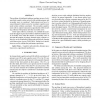Free Online Productivity Tools
i2Speak
i2Symbol
i2OCR
iTex2Img
iWeb2Print
iWeb2Shot
i2Type
iPdf2Split
iPdf2Merge
i2Bopomofo
i2Arabic
i2Style
i2Image
i2PDF
iLatex2Rtf
Sci2ools
ICASSP
2011
IEEE
2011
IEEE
Distributed multiaccess in hierarchical cognitive radio networks
The problem of distributed multiuser medium access of a hierarchical cognitive radio network with multiple primary and secondary users is considered. Each primary user has a licensed channel; it allows access by secondary cognitive users under certain collision constraints. The secondary cognitive users seek to capture transmission opportunities while avoiding collisions with primary and other secondary users. Under tight collision constraints, we establish the maximum throughput region achievable by distributed multiaccess of secondary users when the number of secondary users is less than the number of primary channels using a scheme referred to as the Distributed Orthogonal and Periodic Sensing with Memoryless Access (DOPS-MA). Packet-level simulations are used to validate the performance prediction.
Collision Constraints | ICASSP 2011 | Secondary Cognitive Users | Secondary Users | Signal Processing |
Related Content
| Added | 20 Aug 2011 |
| Updated | 20 Aug 2011 |
| Type | Journal |
| Year | 2011 |
| Where | ICASSP |
| Authors | Shiyao Chen, Lang Tong |
Comments (0)

